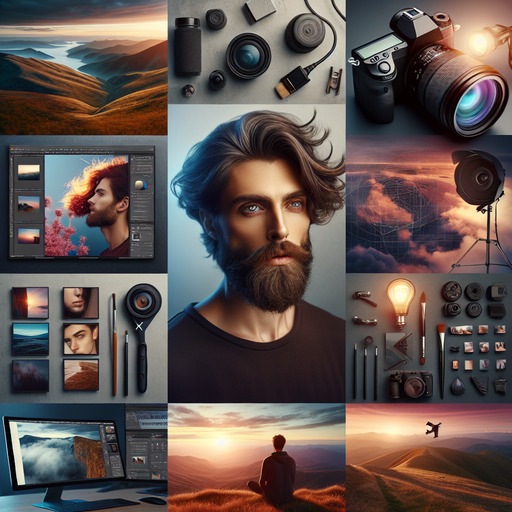
-
Table of Contents
- Mastering Photography: Essential Tips and Techniques for Every Photographer
- Understanding the Basics: Photography Techniques
- Composition: The Rule of Thirds
- Lighting: The Key to Professional Photography
- Advanced Techniques: Elevating Your Photography
- Portrait Photography: Capturing Emotion
- Landscape Photography: Finding the Perfect Scene
- Editing: Enhancing Your Images
- Photography Editing Software
- Photography Gear: Choosing the Right Equipment
- Conclusion: Elevate Your Photography Skills
- Questions and Answers
Mastering Photography: Essential Tips and Techniques for Every Photographer
Photography is more than just capturing moments; it’s about telling stories, evoking emotions, and creating art. Whether you’re a budding photographer or a seasoned professional, understanding the nuances of photography can elevate your work to new heights. In this guide, we’ll explore essential photography tips, techniques, and insights to help you refine your craft and produce stunning images.
Understanding the Basics: Photography Techniques
Before diving into advanced techniques, it’s crucial to master the basics. These foundational skills will serve as the building blocks for your photography journey.
Composition: The Rule of Thirds
One of the most fundamental photography techniques is the rule of thirds. Imagine your image divided into nine equal segments by two vertical and two horizontal lines. Positioning your subject along these lines or at their intersections can create more balanced and engaging photos.
- Example: In landscape photography, place the horizon along the top or bottom third of the frame.
- Case Study: Ansel Adams often used the rule of thirds to create dynamic compositions in his iconic black-and-white landscapes.
Lighting: The Key to Professional Photography
Lighting can make or break a photograph. Understanding how to manipulate light will significantly impact the quality of your images.
- Natural Light: Utilize the golden hour—shortly after sunrise or before sunset—for soft, warm lighting.
- Artificial Light: Experiment with different photography lighting setups, such as softboxes or reflectors, to achieve desired effects.
Advanced Techniques: Elevating Your Photography
Once you’ve mastered the basics, it’s time to explore advanced techniques that can set your work apart.
Portrait Photography: Capturing Emotion
Portrait photography is about more than just capturing a person’s likeness; it’s about conveying their personality and emotions.
- Tip: Engage with your subject to make them comfortable, resulting in more natural expressions.
- Example: Renowned portrait photographer Annie Leibovitz often spends time talking to her subjects before shooting to capture genuine emotions.
Landscape Photography: Finding the Perfect Scene
Landscape photography requires patience and a keen eye for detail. It’s about capturing the beauty of nature in its purest form.
- Tip: Scout locations in advance and return during different times of the day to capture varying light conditions.
- Case Study: National Geographic photographers often revisit locations multiple times to capture the perfect shot.
Editing: Enhancing Your Images
Post-processing is an integral part of modern photography. It allows you to enhance your images and bring your creative vision to life.
Photography Editing Software
There are numerous editing tools available, each offering unique features to enhance your photos.
- Adobe Lightroom: Ideal for batch processing and color correction.
- Photoshop: Offers advanced editing capabilities for detailed retouching.
Photography Gear: Choosing the Right Equipment
Having the right gear can significantly impact your photography. However, it’s essential to choose equipment that suits your style and needs.
- Camera: Consider factors like sensor size, resolution, and features when selecting a camera.
- Lenses: Different lenses offer various perspectives; a prime lens is excellent for portraits, while a wide-angle lens is ideal for landscapes.
Conclusion: Elevate Your Photography Skills
Photography is a journey of continuous learning and experimentation. By mastering the basics, exploring advanced techniques, and investing in the right gear, you can elevate your photography skills and create stunning images that tell compelling stories.
For more insights into photography techniques and tips, visit Wikipedia’s Photography Page.
Questions and Answers
Q1: What is the best time of day for landscape photography?
A1: The golden hour, shortly after sunrise or before sunset, is ideal for landscape photography due to the soft, warm lighting it provides.
Q2: How can I make my portrait subjects feel more comfortable?
A2: Engage in conversation and build rapport with your subjects before and during the shoot to help them relax and express genuine emotions.
Q3: What is the difference between Lightroom and Photoshop?
A3: Lightroom is excellent for batch processing and color correction, while Photoshop offers advanced editing capabilities for detailed retouching and manipulation.
If you’re interested in learning more about photography or our services, please contact us for more information.